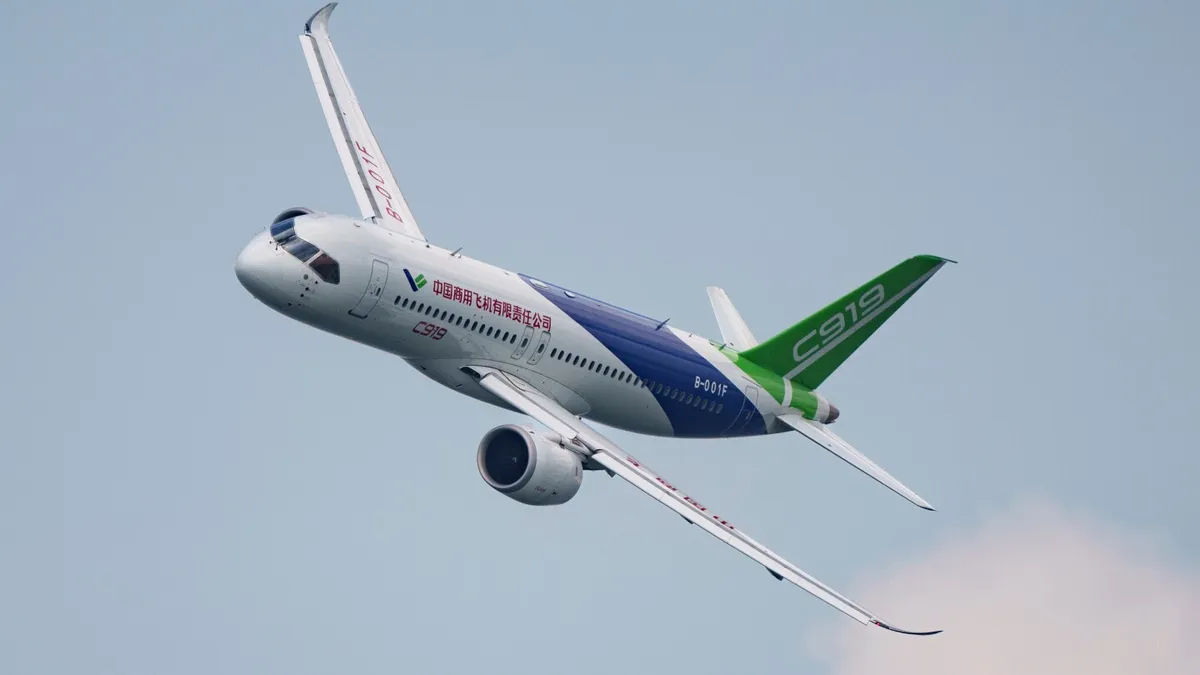
China's ambition to challenge the dominance of Boeing and Airbus in the commercial aviation sector is encountering significant challenges. The country's homegrown passenger jet, the C919, is expected to fall short of its delivery targets for the year. Produced by the state-owned COMAC (Commercial Aircraft Corporation of China), the C919 is a single-aisle passenger plane designed to compete directly with Boeing's 737 and Airbus's A320 models. Despite showcasing this aircraft as a symbol of China’s technological progress and self-reliance, it still relies heavily on components sourced from Western manufacturers.
Trade tensions between the U.S. and China pose a significant risk to the C919 program, particularly in securing essential components. According to Max J. Zenglein, Asia-Pacific senior economist at The Conference Board, "COMAC faces significant risk from the volatile policy environment, with its supply chains vulnerable to export restrictions and tit-for-tat measures between the U.S. and China." The C919's production involves 48 major suppliers from the U.S., including notable companies like GE, Honeywell, and Collins, along with 26 suppliers from Europe and 14 from China, as reported by analysts at the Bank of America.
The ongoing trade friction has been exacerbated by actions from both governments, with former President Trump threatening to impose new export controls on critical software after China enforced stricter controls on rare earth materials. "Existing choke points are being exploited in the deal-making process between governments," Zenglein noted, emphasizing that critical dependencies have become political bargaining chips.
Despite high expectations for the C919, which made its maiden commercial flight in 2023, production numbers have been disappointing. COMAC delivered only 13 C919s to Chinese carriers last year and just seven as of October this year, falling short of its goal of delivering 30 jets by 2025, according to aviation consultancy Cirium. Currently, China's major state-owned airlines—Air China, China Eastern, and China Southern—are the only commercial carriers operating the C919, with a combined total of around 20 aircraft.
The geopolitical tensions between the U.S. and China have had a direct impact on the delivery schedules for the C919. Dan Taylor, head of consulting at aviation consultancy IBA, pointed out that U.S. restrictions on export licenses for the C919's LEAP-1C engines disrupted production plans earlier in the year. The LEAP-1C engines, co-developed by GE Aerospace and Safran of France, require U.S. export clearance, making the C919 program sensitive to political changes. Taylor explained that "Engine and avionics dependence on Western suppliers continues to expose the program to policy decisions beyond COMAC’s control."
While geopolitical tensions play a significant role, they are not the sole reason for the slower-than-expected production of the C919. Zenglein noted that the program is characterized by a focus on quality and safety, which also contributes to operational delays. Although there is a clear aim to reduce reliance on foreign components, analysts agree that this is a complex and challenging process. The development of China’s own engine alternative, the CJ-1000A, by the state-owned Aero Engine Corporation of China (AECC), is still underway and undergoing testing, adding to the uncertainties surrounding the C919's future.
Several airlines outside of China, including AirAsia, have shown interest in operating the C919. However, the lack of international certification has so far prevented the aircraft from flying beyond Chinese airspace. Obtaining certifications from U.S. and European aviation regulators could take years, complicating the C919's global expansion plans. To truly succeed in the competitive aviation market, the C919 must achieve three critical objectives: robust economics, an efficient global product support network, and certification from safety agencies. As Richard Aboulafia, managing director of AeroDynamic Advisory, stated, "Any one of these three alone doesn’t mean much."
According to Airbus’s latest market forecast, China will require approximately 9,570 new passenger aircraft between 2025 and 2044, with over 80% of these being single-aisle jets like the C919. However, COMAC faces intensifying competition from Airbus, which is expanding its manufacturing capacity in China. A second assembly line dedicated to producing A320 single-aisle jets is set to commence operations in 2026, further challenging COMAC’s market position.
In conclusion, while there are hopes for the C919 to eventually disrupt the Boeing-Airbus duopoly, analysts predict that it will take years for COMAC to establish a foothold in the global aircraft market. As noted by Taylor from IBA, the current lack of international certification will delay meaningful entry into Western markets, and ongoing export control volatility is likely to hinder its global ambitions.